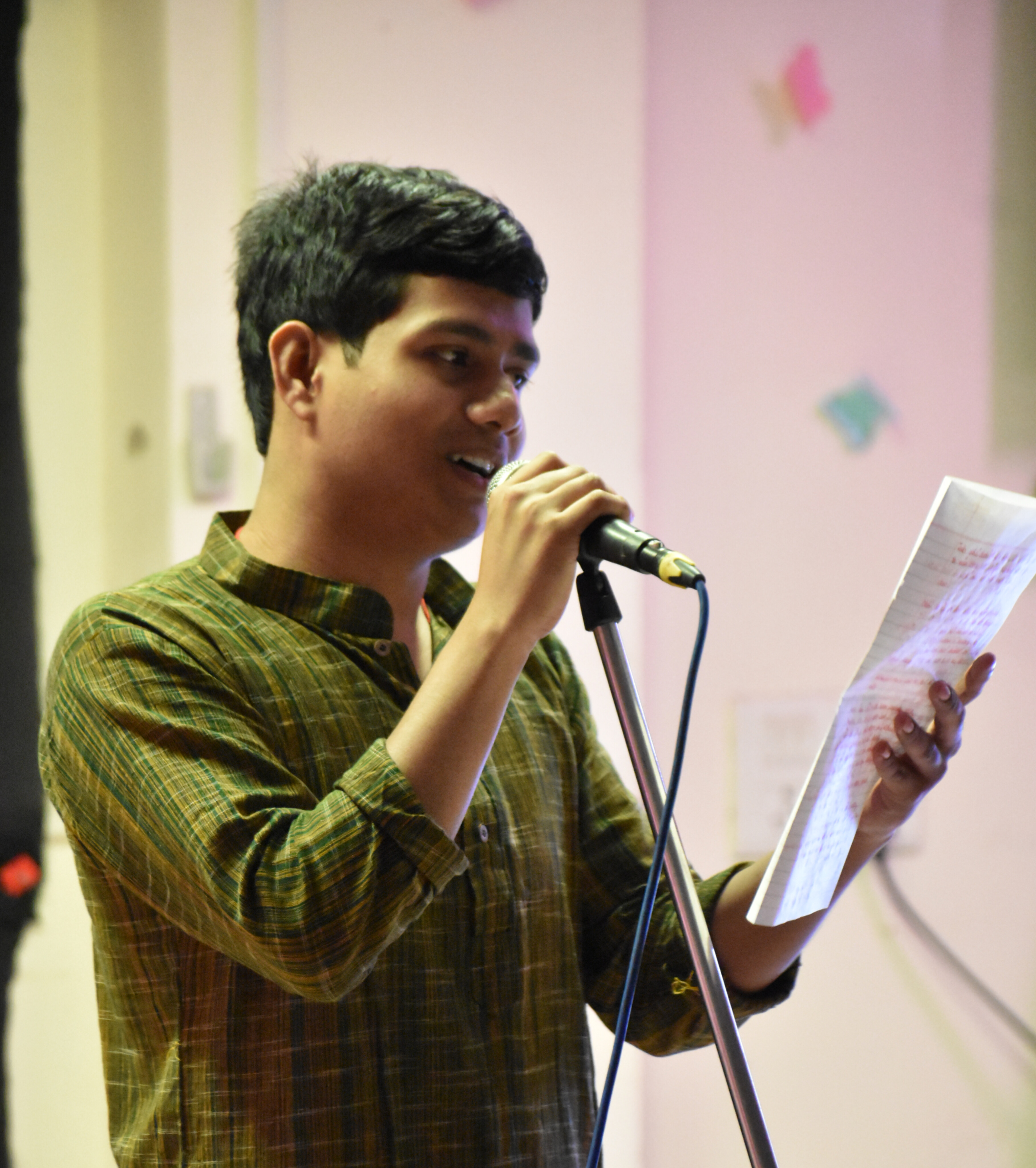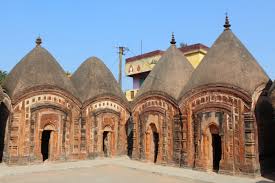
THE GAUNPUR TEMPLES OF BIRBHUM
In India’s historical past in general and Bengal in particular, temples have always played an important role, not only as a religious centre, but also it acted as a centre of cultural, economic, social, and political landscape. Unlike the other temple architecture of India, Bengal temples are quite distinctive due to the usage of a high amount of terracotta figurines that carry the visual of local myths, traditions, village society, and sometimes depict the agrarian economic structure of the village in a general sense. That’s why it would be incorrect to state that temples were only made for religious purposes. For example, during the period of Harshavardhana, the temple was not merely a religious centre, but rather it was the record keeper of land grants, transactions, and village economic activities. This article will show us the artistic, cultural, social, traditional, and aesthetic vision of the temples of Birbhum district, West Bengal.

BISHNUPUR TERRACOTTA TEMPLE
INTRODUCTION: OVERVIEW OF WEST BENGAL’S TERRACOTA TEMPLE TRADITION
It is said that West Bengal has always been the hub of terracotta temple architecture from the ancient period, which depicts the enduring legacy of regional identity and history, and also carries artistic excellence. From historical data, it is said that the origin of these temples could be traced between the 16th and the 18th century, a period where creativity was at its peak and the artisans of Bengal found their creative expression and voice through art and architecture. One of the main features of this period is that temples were made to preserve the local myths, traditions, and oral history. The terracotta temple architecture found its proper shape during the reign of regional rulers such as the Malla kings of Bishnupur and Rani Bhavani.
The basic reason behind the rise of terracotta temples in Bengal was the lack of stone resources. The primary source of the construction of this temple was terracotta material. This lack of stones forced the artisans to think innovatively. As a result, it led to the creation of temples through terracotta materials due to the high amount of availability of clay. These clays were being baked or fired properly to give a profound shape to create temples. This period shows an innovative shift from stone to clay material.
The terracotta craft was prevalent from the reign of the Pala dynasty, but the actual shape of this terracotta craft was found through temple architecture after the decline of the Bengal Sultanate. The Bishnupur region of Bengal is regarded as an important and most crucial centre of terracotta temple architecture, and it has also been recognized as a UNESCO World Heritage Site.
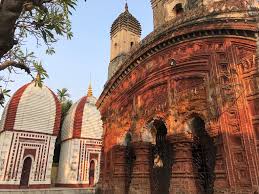
TEMPLES OF SURUL, BIRBHUM
ARTISTIC CREATIVITY & HISTORICAL TRAJECTORY OF BIRBHUM DISTRICT
Birbhum district of West Bengal carries a long and significant historical past. This district is situated in the ancient region of Rarh, which was predominantly under the Delhi Sultanate during the 13th century and ultimately came under the English East India Company in the year 1765. The architectural evolution in Bengal saw its gradual rise after the conquest of Bengal, where we find the prevalence of terracotta craft also an important ingredient. But in case of popularity and richness, the terracotta temple architecture of Birbhum got the final shape in the 16th century, where we find the intermingling of religiousness, creativity, and preservation of local or oral tradition, and one of the most renowned examples is the Hatakali Temple of Itanda village in Birbhum. From this temple, we find a compelling example of cultural synthesis that shows the fascinating blend of Hindu, Muslim, and even Christian religious identity.
From the historical past, we always knew that the temples or any kind of religious centres were funded and looked after by the royal patronage, but this got shifted to local families or communities and by the 1800s, places such as Illambazar of Birbhum became the important centres of trade and commerce that brought huge flow of income. This helped the local families or communities to fund the temples in general and terracotta temples in particular, such as the Hathtala Gauranga Mahaprabhu Temple or the Lakshmi Janardan Temple of 1846. This terracotta temple is still funded by the Ojha family to this date. This transfer of royal patronage to local communities or families shows us the flexible nature of Birbhum culture. Thus, the temples were not only the religious centres, but they also acted as the carriers of the legacy of local communities or families.
The most important feature of the terracotta temples of Birbhum is that they have a sloping roof, which is also called ‘chala’. They are nothing but huts of the traditional villages of Bengal. It shows the intermixing of local styles and their patronage and visibility through temple architecture. These terracotta temples of Birbhum are grouped based on different variations of roofs, and it is their main feature. The types of roofs are as follows:
A. The temples that carry two roofs that are curved and join at the top as like the village hut. This type of roof is called Do Chala/Ek Bangla/Jor Bangla.
B. The temples that carry four triangular roofs that are curved and meet at one point. This kind of roofing system is prevalent in Birbhum, very rare to find in the other districts of West Bengal. This type of roofing system is called Char Chala.
C. The temples which have tower kind of structure that rises upwards. This is called Deul.
D. The most uncommon is the octagonal shape temples of Birbhum, such as the Gouranga Mahaprabhu Temple of Illambazar.
The architectural style of the Terracotta temples of Birbhum carries a rich legacy of history, tradition, and local customs.
THEMES AND MOTIFS OF THE TERRACOTTA TEMPLES OF BIRBHUM
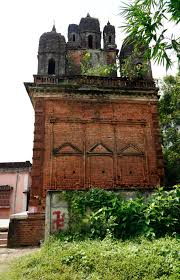
LAXHMI JANARDAN TEMPLE OF BIRBHUM
The terracotta temples of Birbhum district laid the legacy of Bhakti, Vaishnavism, and the Shaka themes and traditions. The influence of the Bhakti movement is very high in these temples. Not only the local mythologies but also the popular myths, such as Ramayana, Mahabharata, and the childhood period of Lord Krishna, the sacred union of marriage between Ram and Sita, Pitamah Bhishma lying on the bed of arrows, the popular story of Lakshman and Surpanakha, Goddess Parvati with her sons such as Kartikya and Ganesha, the depiction of Goddess Durga killing the Mahisasura, the rise of Mahakali and cutting the heads of Chund and Mund, and many more.
Apart from this religious and mythological depiction, we also find the depiction of daily life activities such as hunting, musical performances, dancers dancing, various social customs such as marriage, the Bengali household ceremonies, depiction of local goddesses such as Manasa devi, Shitla devi, rural village structures such as farmers milking their cows in the temples such as the Lakshmi Janardan temple of Illambazar, buffaloes and cows holding bullock carts depicted on the Chand Rai Thakur Jiu temple of Uchchakaran village, boates as an important medium of transportation on the Gopal Temple of Ghurisa, groom and the bride playing the popular game of Kaudi (sea shells) on the Char Chala Shiva Temple of Uchchakaran village.
Even in a few temples of Birbhum, we find certain depictions of Western architectural elements, mainly in the Mahaprabhu Temple of Illambazar, as Illambazar was the hub of British trade for indigo, cotton, and sugarcane. This not only shows the insular nature of the terracotta temple of Birbhum but also depicts the absorption of external cultural influences. The other important temples of Birbhum, such as the Radha Vinod Temple of Kenduli, depict the Baul singers and their daily activities. Thus, the terracotta art in Birbhum temples gave us very ethnographic records, which show us the flourishing of both the regional and the popular culture that is deeply rooted in local customs and traditions. That’s why the terracotta temples of Birbhum make it unique in nature and in characteristics.
CURRENT STATE OF THE TERRACOTTA TEMPLES OF BIRBHUM
The most common question that can arise that what is the current state of these temples. The answer lies in climate change and disastrous weather conditions, which are gradually leading to the sudden decay and loss of artefacts and the motifs on the walls of the temples. From the sites of the Durbajpur region, the temples are in a very poor state due to severe hot and cold climate conditions and a lack of preservation, and they are not under the protection of the West Bengal State Archeological Department. It’s high time to call for an immediate effect as early as possible. Maluti temples near the Birbhum Jharkhand border are in the phase of loss, as most parts of the temple have decayed. This is leading to the decline of cultural as well as oral traditions. These are happening due to a lack of maintenance from the government as well as from the local people, and the rise of overgrown vegetation. The environmental factors are also leading to its damage. The most trendy cause of their decline is climate change. But few of the temples are under the maintenance of the State Archeology Department, such as the Hathtala Gauranga Mahaprabhu Temple of Illambazar. However, this nominal contribution to historical preservation is not enough. These temples carry history itself. If these decays then it will heavily impact the oral historians for their research purposes.

DEPICTIONS ON THE HATHTALA GAURANGA MAHAPRABHU TEMPLE OF ILLAMBAZAR
CONCLUSION
The Birbhum region occupies the most artistic and creative position in the rich history of West Bengal, in particular, and India in general. These terracotta temples show us the unique blend of craft, creative intelligence, and local tradition in the forms of temples. The narration that these temples hold is tremendously unique and rich in its nature, and for a historian, it is one of the most crucial primary sources for reconstructing the history of regional temples of Bengal. The most beautiful feature of the temples of Birbhum district is that they not only show the cultural intermingling but also depict the influence of external matters and their impact on the reconstruction of the temples.
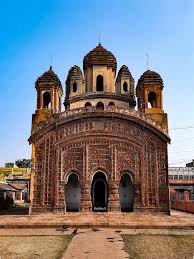
RADHA VINOD TEMPLE OF BIRBHUM
WORKS CITED
“Ancient Heritage of Terracotta Temples in West Bengal.” SetMyTrip, 4 December 2024, https://www.setmytrip.in/ancient-heritage-of-terracotta-temples-in-west-bengal/. Accessed 20 June 2025.
GUPTA, AMITABHA. “Terracotta Temples around Shantiniketan, Part – II ( Ilambazar and Ghurisha).” Amitabha Gupta, 7 January 2015, https://amitabhagupta.wordpress.com/2015/01/07/terracotta-temples-around-shantiniketan-part-ii-ilambazar-and-ghurisha/. Accessed 21 June 2025.
“Hath-tala Gauranga Mahaprabhu Temple – Illambazar – Kevin Standage.” Kevin Standage, 13 March 2023, https://kevinstandagephotography.wordpress.com/2023/03/13/hath-tala-gauranga-mahaprabhu-temple-illambazar/. Accessed 21 June 2025.
“Maluti temples.” Wikipedia, https://en.wikipedia.org/wiki/Maluti_temples. Accessed 21 June 2025.
“Terracotta Temples of Birbhum: An Ethno-archaeological Prospect.” Heritage: Journal of Multidisciplinary Studies in Archaeology, https://www.heritageuniversityofkerala.com/JournalPDF/Volume5/48.pdf. Accessed 21 June 2025.
“The Terracotta Temples of Dubrajpur – Kevin Standage.” Kevin Standage, 19 March 2023, https://kevinstandagephotography.wordpress.com/2023/03/19/the-terracotta-temples-of
-dubrajpur/. Accessed 21 June 2025.

